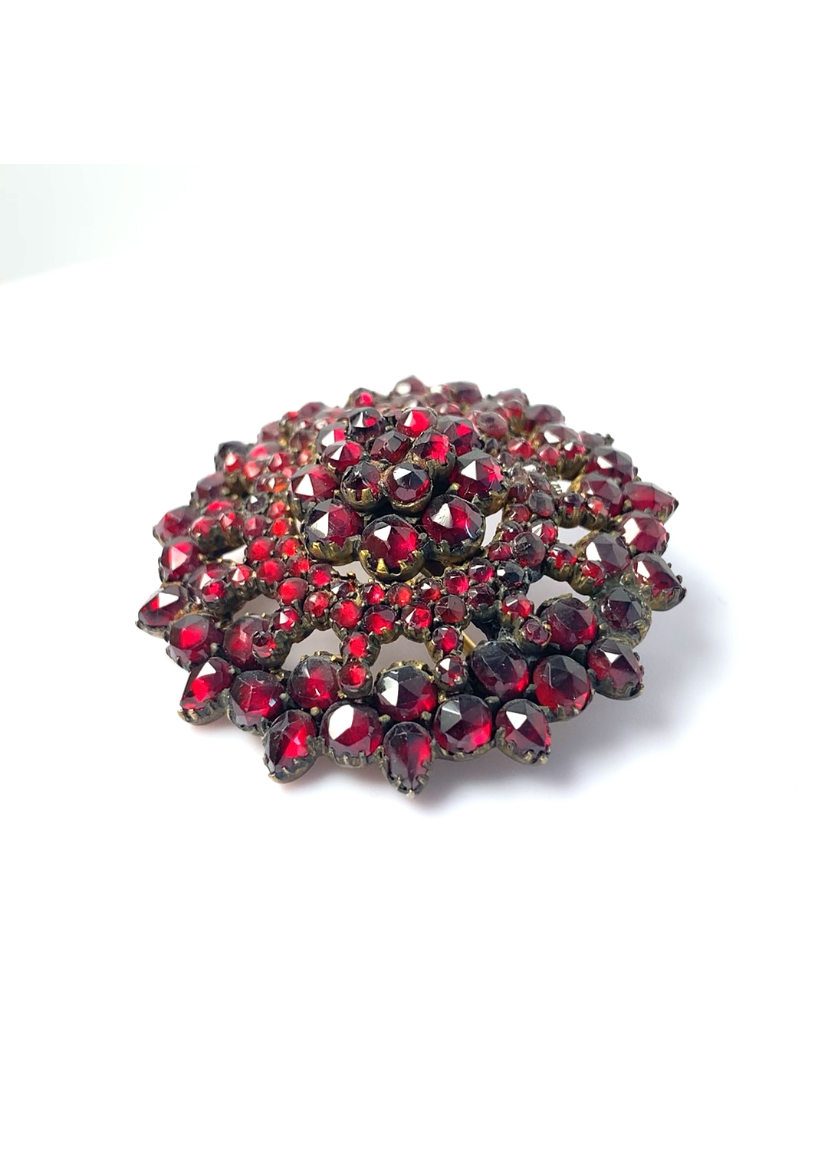Nowhere else, colour is captured more persistently than in gemstones, which is why gemstones have fascinated mankind from the beginning.
The human colour receptor cells are preferably triggered by blue, green and red: and these colours are just those that have always been preferred for gemstones throughout the history of mankind.
Looking at it from a historical and cultural perspective, garnet is considered one of the most important red gemstones as people have been using it for adorning for thousands of years. We know from studying ancient graves that people wore garnet necklaces even in prehistoric times.
During historic times, the use of garnets for jewellery purposes can be traced for the last three thousand years or so. The determination of garnet origin in historic pieces of jewellery can be used as indicators of trade relations and trade routes in ancient times.
The translation of the hebrew bible into greek, around 300 B.C. in Alexandria, can be considered being among the eldest literature mentioning garnet gemstones: “Anthrax” is among the twelve gemstones symbolizing the twelve tribes of Israel.
The writings of Theophrastos (372-287 v. Chr.) (griech. Peri lithon = in latin translation “De lapidibus“ = „About Stones”) and Pliny the Elder (23 – 79 n. Chr.) [ Historia naturalis = „Natural History“] can be considered being the oldest primary scientific sources. In contrast to later writings in medieval times, which mainly concentrated on allegoric and mythological meanings of gemstones, the writings of these two ancient authors are giving details of observations that are rationally understandable.
The greek philosopher Theophrastos is using the term “anthrax” for describing ordinary coal, which burns in a fire, as well as for red gemstones with high hardness, which do not burn in a fire, but glow like burning coal when viewed in direct sunlight. Although Theophrastos is using the same term, both types of “anthrax “ are clearly distinguished by their different properties.
Based on the mineralogical knowledge at that time, it seems to be most likely that “anthrax” was used as a generic term that embraced several red gemstones such as ruby, red spinel and red garnet.
Due to a note of Theophrastos, that „anthrax“ gemstones were used for seals, it is quite safe to guess that Theophrastos meant red garnet, when referring to the gemstone “anthrax”. In hellenistic times (Theophrastos is a contemporary of Alexander the Great) the usage of garnet as sealstones shows a peak in antique jewellery pieces, whereas no ruby sealstones are known from that period.
Carthago and the city now known as Marseille, at the time important Phoenician trade hubs, are explicitly mentioned as trading centres (not: place of origin) for anthrax. Milet in Asia Minor could be both, place of origin and trade hub.
Pliny the Elder translates „anthrax“ into „carbunculus“, and describes the glowing of “carbunculi” when held against the against the sunrays („contra radios solis scintillare“).
Plinius mentions the same trade hubs as Theophrastos, but adds Ethiopia, Alabanda, Egypt and Arabia. Alabanda, near Milet, is mentioned as a cutting centre.
Authors of the medieval period, namely Marbodus (1035-1123 n. Chr.), Arnoldus Saxo (um 1200 n. Chr) and Hildegardis von Bingen (1098-1179 n. Chr.) mainly concentrate on allegoric or mythological interpretations on grounds of the ancestral literature without adding new knowledge about the properties and occurrences of “anthrax” or “carbunculi”.
But, it also can be mentioned, that the birth of the term “garnet” itself lay in the middle ages:
Albertus Magnus (1193 – 1280 n.Chr.) distinguishes between „rubinus“, „granatus“ und „belagius“ as being three different types of „carbunculi“. It seems likely, that the term “granatus” was derived from “granum”=lat. “seed”, making reference to the red colour of the seeds of pomegranate.
The picture above, which shows a garnet crystal in its mother rock, nicely illustrates the etymological development of the terms garnet, pyrope and carbuncle: Fiery-eyed (pyropos) grain (granum), glowing in the rays of the sun like burning coal (carbunculus).
During the renaissance period, mineralogy and metallurgy began to flourish and were recognised by European emperors as an important source of wealth for their growing economies.
Not surprisingly, the exploration of gold and silver ores had top priority, but the rulers also sponsored specifically the search for gemstones and have paid close attention to the development of fine jewellery and gemstone cutting and carving.
Pyrope and Almandine
Only after routine chemical analysis of minerals in the 19th century had been established, the separation of red garnets into two mineral species was possible:
Pyrope, a magnesium-aluminum-silicate
and
Almandine, an iron-aluminum-silicate.
With the advancement of scientific knowledge it was also found, that all natural garnets need to be described as mixtures (solid solutions) between ideal end member species, that do not exist in purity in nature. For practical reasons, a solid solution between several end members will be named after the “majority” end member, e.g. Pyrope or Almandine.









